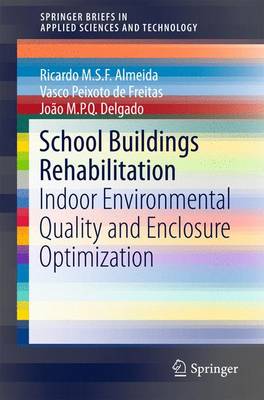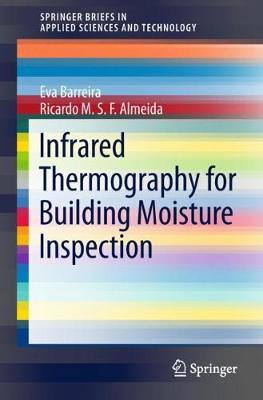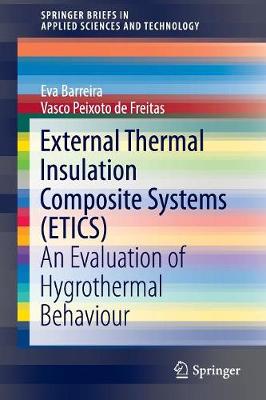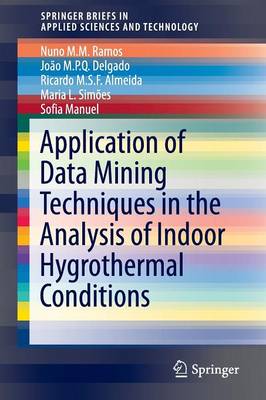SpringerBriefs in Applied Sciences and Technology
6 total works
School Buildings Rehabilitation
by Ricardo M.S.F. Almeida, Vasco Peixoto de Freitas, and Joao M.P.Q. Delgado
This book discusses the effect of different school building rehabilitation strategies on the classrooms' indoor environmental quality (IEQ) and presents a multi-objective methodology for school building enclosure optimization combining artificial neural networks and lifecycle costs. The special features of this book are that it (a) presents the state-of-the-art in school building rehabilitation, (b) covers the IEQ assessment of several school buildings, including non-rehabilitated and rehabilitated according to different strategies; and (c) proposes a multi-objective optimization procedure.
The rehabilitation of a school building should be regarded as a procedure combining a number of (sometimes conflicting) variables and objectives, including energy, IEQ and costs (initial, operational and maintenance), in the search for an "optimum solution." The main benefit of the book is that it discusses the main topics related to school building rehabilitation, presents results of the IEQ assessment on 9 school buildings and launches a discussion on how the "in-use" performance of schools is key to understanding how designed performance is actually experienced. It maps the most commonly used multi-objective algorithms and artificial neural network architectures and proposes a methodology for combining these numerical tools with dynamic building simulations and lifecycle cost analysis to optimize school building enclosures. This methodology will be of value to scientists and engineers alike, while also addressing a variety of related disciplines, such as civil and mechanical engineering, architecture and mathematics.
Hygrothermal Risk on Building Heritage
by Joao M.P.Q. Delgado, Ana Sofia Guimaraes, and Vasco Peixoto de Freitas
This book presents a critical review of a criterion of risk, created to assess the flood risk to heritage buildings, and evaluates this criterion by applying it to the sample Portuguese heritage buildings. In a first approach, the total number of potential parameters is effectively reduced and the selected criteria are divided into two different groups: the monument's location in relation to a waterway, and the behaviour of its construction material in contact with water.
Above all, the book discusses the importance of architectural heritage and argues for the need to safeguard it from extreme climatic phenomena such as floods. As such, the book vividly reminds the scientific community that the intensification of the global warming and climate change will worsen throughout the 21st century, and that it is therefore necessary to adopt preventive measures to minimize, mitigate and control these adverse effects if we hope to avoid catastrophic consequences.
At the same time, the book takes into account a broad range of scientific and engineering disciplines, such as civil engineering and architecture, offering a synthesis of the current state of knowledge to benefit and guide experts and practitioners in related fields.
Infrared Thermography for Building Moisture Inspection
by Eva Barreira and Ricardo M.S.F. Almeida
This book presents the state-of-the-art in infrared thermography (IRT) applications with a focus on moisture assessment in buildings. It also offers practical discussions of several case studies, including comparisons of IRT with other surface temperature measurement techniques. In closing, it demonstrates how IRT can be used to assess capillary absorption, and addresses moisture in walls due to wind-driven rain infiltrations, and the drying process.
The book equips readers with a deeper understanding of the ideal conditions for accurate IRT assessment and offers practical recommendations.
Hygrothermal Numerical Simulation Tools Applied to Building Physics
by Joao M.P.Q. Delgado, Eva Barreira, Nuno M.M. Ramos, and Vasco Peixoto de Freitas
During the past few decades there has been relevant development in this field of study and an increase in the professional use of tools that simulate some of the physical phenomena that are involved in Heat, Air and Moisture conditions in building components or elements. Although there is a significant amount of hygrothermal models referred in the literature, the vast majority of them are not easily available to the public outside the institutions where they were developed, which restricts the analysis of this book to only 14 hygrothermal modelling tools.
The special features of this book are (a) a state-of-the-art of numerical simulation tools applied to building physics, (b) the boundary conditions importance, (c) the material properties, namely, experimental methods for the measurement of relevant transport properties, and (d) the numerical investigation and application
The main benefit of the book is that it discusses all the topics related to numerical simulation tools in building components (including state-of-the-art and applications) and presents some of the most important theoretical and numerical developments in building physics, providing a self-contained major reference that is appealing to both the scientists and the engineers. At the same time, this book will be going to the encounter of a variety of scientific and engineering disciplines, such as civil and mechanical engineering, architecture, etc… The book is divided in several chapters that intend to be a resume of the current state of knowledge for benefit of professional colleagues.
External Thermal Insulation Composite Systems (ETICS)
by Eva Barreira and Vasco Peixoto de Freitas
This book analyzes the hygrothermal behaviour of external thermal insulation composite systems (ETICS), components that increase the thermal efficiency of buildings. Treating a topic that has largely been neglected, it explores the main cause of biological growth within ETICS. The results of two experimental test series are presented: (i) a long-term assessment of four facades covered with ETICS and (ii) an evaluation of the factors affecting the facades' hygrothermal behaviour. Furthermore, using a previously validated numerical model, it presents a sensitivity analysis of the hygrothermal behaviour of facades coated with ETICS. It also provides a methodology to assess the surface humidification of ETICS, which combines the effect of surface condensation, wind-driven rain and the drying process (three of the most prevalent parameters influencing the surface moisture content), which can then be used as a decision-support tool. ETICS are now frequently used in Europe to improve the thermal efficiency of buildings. Despite their advantages in terms of thermal efficiency, their low cost and their ease of application, these systems are adversely affected by microbiological growth, which causes defacement of cladding. Although the thermal and mechanical performance of the system is not impaired, biological defacement has an enormous aesthetic impact, affecting the inhabitants' living experience and restricting the full implementation of this technology. External Thermal Insulation Composite Systems (ETICS): An Evaluation of Hygrothermal Behaviour provides a valuable resource to engineers and architects utilizing ETICS in their work, and for researchers and students interested in the hygrothermal behaviour of ETICS. It is also intended for those employed in industry and manufacturers of ETICS.
Application of Data Mining Techniques in the Analysis of Indoor Hygrothermal Conditions
by Nuno M.M. Ramos, Joao M.P.Q. Delgado, Ricardo M.S.F. Almeida, Maria L. Simoes, and Sofia Manuel
The main benefit of the book is that it explores available methodologies for both conducting in-situ measurements and adequately exploring the results, based on a case study that illustrates the benefits and difficulties of concurrent methodologies.
The case study corresponds to a set of 25 social housing dwellings where an extensive in situ measurement campaign was conducted. The dwellings are located in the same quarter of a city. Measurements included indoor temperature and relative humidity, with continuous log in different rooms of each dwelling, blower-door tests and complete outdoor conditions provided by a nearby weather station.
The book includes a variety of scientific and engineering disciplines, such as building physics, probability and statistics and civil engineering. It presents a synthesis of the current state of knowledge for benefit of professional engineers and scientists.





